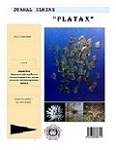Amplification Of Bacterial Isolate Sf1 Associated With Sponge Facaplysynopsis sp. From Tongkeina, North Sulawesi
DOI:
https://doi.org/10.35800/jip.6.2.2018.20636Abstract
This study was conducted with the aim of amplifying the isolate of SF1 symbiont sponge Facaplysynopsis sp. Â from Tongkeina, North Sulawesi. Samples are obtained and stored in the Lab. Molecular Biology and Marine Pharmacology, FPIK Unsrat. The genomic DNA of the samples was isolated using protocols from the Innu PREP Mini DNA Kit. The DNA of the SF1 symbionary bacteria was amplified by PCR (Polymerase Chain Reaction) using an 8F primer (5'-AGAGTITGATCCTGGCTA-3 ') and 1492 R (5'TACCTTACGACTT-3'). DNA bacteria SF1 successfully amplified marked by the appearance of the band of DNA that looks less clear, with a length of 600 bp.
Keywords: Bacterial Isolate, Sponge, Amplification
ABSTRAK
Penelitian ini dilakukan dengan tujuan mengamplifikasi isolat bakteri SF1 simbion spons Facaplysynopsis sp dari perairan Tongkeina, Sulawesi Utara. Sampel diperoleh dan tersimpan di Lab. Biologi Molekuler dan Farmasitika Laut, FPIK Unsrat. DNA genom dari sampel diisolasi menggunakan protokol dari Innu PREP DNA Mini Kit. DNA bakteri simbion SF1 diamplifikasi dengan PCR (Polymerase Chain Reaction) dengan menggunakan primer 8F (5’-AGAGTITGATCCTGGCTA-3’) dan 1492 R (5’TACCTTACGACTT-3’). DNA bakteri SF1 berhasil diamplifikasi ditandai dengan munculnya pita DNA yang terlihat kurang jelas, dengan panjang 600 bp.
Kata Kunci: Bakteri Simbion, Spons, Amplifikasi
Downloads
Published
How to Cite
Issue
Section
License
COPYRIGHT
Authors who publish with this journal agree to the following terms:
Authors hold their copyright and grant this journal the privilege of first publication, with the work simultaneously licensed under a Creative Commons Attribution License that permits others to impart the work with an acknowledgment of the work's origin and initial publication by this journal.
Authors can enter into separate or additional contractual arrangements for the non-exclusive distribution of the journal's published version of the work (for example, post it to an institutional repository or publish it in a book), with an acknowledgment of its underlying publication in this journal.
Authors are permitted and encouraged to post their work online (for example, in institutional repositories or on their website) as it can lead to productive exchanges, as well as earlier and greater citation of the published work (See The Effect of Open Access).




















